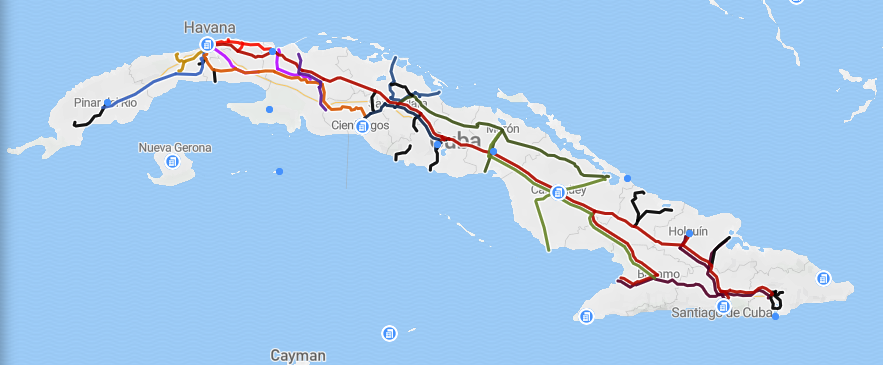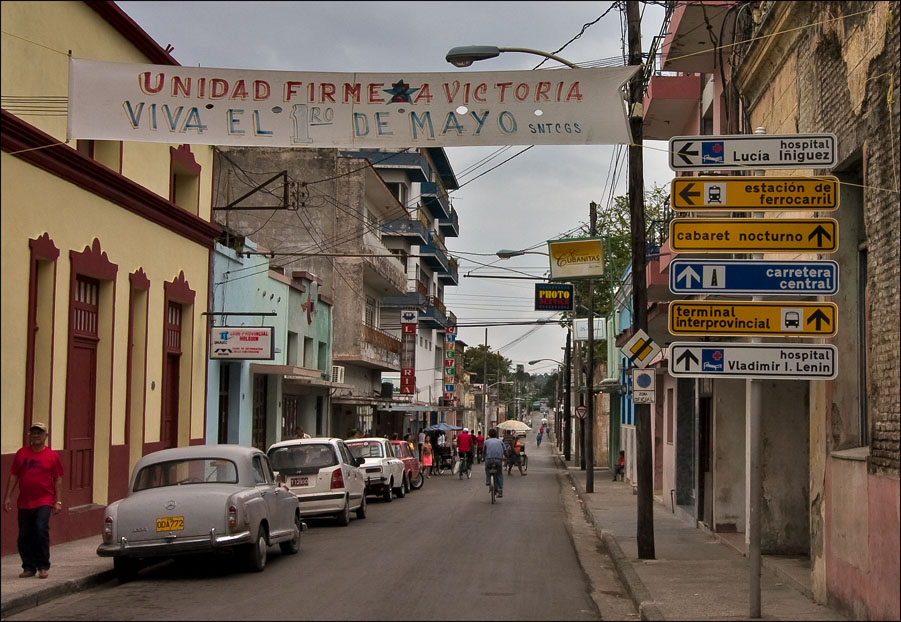|
Camagüey Railway Station
Camagüey is the main railway station of the Camagüey, city of Camagüey, seat of Camagüey Province, the homonym province, Cuba. The station, informally known as ''Camagüey Central'', is owned by the state company Ferrocarriles de Cuba (FFCC) and is located in the Avenida Van Horne, in the middle of the city and just in front of the Hotel Plaza. It is one of the most important stations of Cuba and, along with Havana Central railway station, Havana Central, Santiago de Cuba railway station, Santiago and Santa Clara railway station (Cuba), Santa Clara, is a network's divisional headquarter. History The station was projected in 1830s and opened on 5 April 1846. It was the southern terminus of the line to the town of Nuevitas, on the Atlantic Ocean, Atlantic Coast. Structure Camagüey station has a large one-floor Station building, building in Spanish Colonial architecture, Spanish Colonial style. It counts 3 Track (rail transport), tracks, and the third serves a minor Goods shed ... [...More Info...] [...Related Items...] OR: [Wikipedia] [Google] [Baidu] |
Ferrocarriles De Cuba
Ferrocarriles de Cuba (FCC) or Ferrocarriles Nacionales de Cuba (English: National Railway Company of Cuba), provides passenger and freight services for Cuba. Route network Ferrocarriles de Cuba uses that extends from Guane (province Pinar del Río) in the westernmost part of the island up to the bay of Guantánamo in the eastern part. The Central railway runs from Havana to Santiago de Cuba in the eastern region. Most of the system is diesel-powered with electrified. The flagship Train Number 1 travels between Havana and Baracoa. Other long-distance passenger services link Havana to Pinar del Río (western railway), Cienfuegos (South branch), Sancti Spíritus, Bayamo-Manzanillo and Guantánamo. The network connects the six first-level ports in Cuba: Havana, Mariel, Matanzas, Cienfuegos, Nuevitas and Santiago de Cuba, as well as all provincial capital cities. The Hershey Electric Railway is an electrified railway from Havana to Matanzas that was built by the Hershey Company ... [...More Info...] [...Related Items...] OR: [Wikipedia] [Google] [Baidu] |
Bayamo
Bayamo is the capital city of the Granma Province of Cuba and one of the largest cities in the Oriente region. Overview The community of Bayamo lies on a plain by the Bayamo River. It is affected by the violent Bayamo wind. One of the most important education institutions in the province is the University of Granma. History Established in 1513, Bayamo was the third of seven cities founded by Diego Velázquez de Cuéllar. Francisco Iznaga, a Basque landowner in the western portion of Cuba during the first 30 years of the colonization of Cuba, was elected mayor in 1540. Iznaga was the originator of a powerful lineage that finally settled in Trinidad, where the Torre Iznaga (Iznaga Tower) is. His descendants fought for the independence of Cuba and for annexation to the U.S., from 1820 to 1900. During much of the 16th century it was one of the most important agricultural and commercial settlements of the island. Its inland situation gave it relative security against the pirat ... [...More Info...] [...Related Items...] OR: [Wikipedia] [Google] [Baidu] |
Guantánamo
Guantánamo (, , ) is a municipality and city in southeast Cuba and capital of Guantánamo Province. Guantánamo is served by the Caimanera port near the Guantanamo Bay Naval Base, site of a U.S. naval base. The area produces sugarcane and cotton wool. These are traditional parts of the economy. History The city was founded in 1797 in the area of a farm named ''Santa Catalina''. The toponym "Guantánamo" means, in Taíno language, "land between the rivers".Guantánamo on EcuRed Geography The municipality is mountainous in the north, at Alejandro de Humboldt National Park, where it overlays the Sierra Maestra (mountains), and borders the Windward Passage of the Caribbean Sea in the south. It is crossed by the Bano, Guantánamo, Yateras, Guaso, San Andrés, and Sabanalamar rivers. The city is spread with a sq ...[...More Info...] [...Related Items...] OR: [Wikipedia] [Google] [Baidu] |
Holguín
Holguín () is a municipality and city in Cuba, and the capital of Province of Holguín. After Havana, Santiago de Cuba, and Camagüey, it is the fourth largest city in Cuba. History Before Columbus, the Taino people settled in huts made from royal palm in the Holguin area later urbanized by the Spanish; their artifacts are shown at the local Holguin La Periquera museum. The settlement was founded in 1523 on land donated by Diego Velázquez de Cuéllar to Captain Francisco García Holguín, a Spanish military officer. Holguin added his maternal surname to the name of the town, giving it the name San Isidoro de Holguín. Prior to 1976, Holguín was located in the province of Oriente. Before Pope Francis's visit to the United States, in September 2015, he visited Cuba, and one of his stops was at the Diocese of Holguín to, among other things, commemorate the location where Christopher Columbus landed. Geography The municipality is divided into ''repartos'' or barrios. The ol ... [...More Info...] [...Related Items...] OR: [Wikipedia] [Google] [Baidu] |
Santiago De Cuba
Santiago de Cuba is the second-largest city in Cuba and the capital city of Santiago de Cuba Province. It lies in the southeastern area of the island, some southeast of the Cuban capital of Havana. The municipality extends over , and contains the communities of Antonio Maceo, Bravo, Castillo Duany, Daiquirí, El Caney, El Cobre, El Cristo, Guilera, Leyte Vidal, Moncada and Siboney. Historically Santiago de Cuba was the second-most important city on the island after Havana, and remains the second-largest. It is on a bay connected to the Caribbean Sea and an important sea port. In the 2012 population census, the city of Santiago de Cuba recorded a population of 431,272 people. History Santiago de Cuba was the fifth village founded by Spanish conquistador Diego Velázquez de Cuéllar on July 25, 1515. The settlement was destroyed by fire in 1516, and was immediately rebuilt. This was the starting point of the expeditions led by Juan de Grijalba and Hernán Cortés to the ... [...More Info...] [...Related Items...] OR: [Wikipedia] [Google] [Baidu] |
Santa Clara, Cuba
Santa Clara is the capital city of the Cuban province of Villa Clara Province, Villa Clara. It is centrally located in the province and Cuba. Santa Clara is the List of cities in Cuba, fifth-most populous Cuban city, with a population of nearly 250,000. History Santa Clara was founded by 175 people on July 15, 1689. 138 of them represented two large families already living in the area, who owned land next to the new city. The other 37 came from seven other families and included a priest and governor, all originating in the coastal city of San Juan de los Remedios. The population of Remedios, Cuba, Remedios had to choose between leaving their city, constantly being besieged by pirates, or staying. While most decided to stay, 37 people traveled south to the interior. On June 1, 1689, they arrived at a hill, joining two other families already present at the site. According to tradition, a mass was celebrated under a tamarind tree and Santa Clara was founded. Since then, the pla ... [...More Info...] [...Related Items...] OR: [Wikipedia] [Google] [Baidu] |
Havana
Havana (; Spanish: ''La Habana'' ) is the capital and largest city of Cuba. The heart of the La Habana Province, Havana is the country's main port and commercial center.Cuba ''''. . The city has a population of 2.3million inhabitants, and it spans a total of – making it the largest city by area, the most populous city, and the [...More Info...] [...Related Items...] OR: [Wikipedia] [Google] [Baidu] |
Tren Francés
''Tren Francés'' (Spanish for "French Train") was the name of the flagship Cuban InterCity service between Havana and Santiago. Owned by Ferrocarriles de Cuba, it was operated by SNCF ex-Trans Europ Express (TEE) , originally used in Europe between Paris and Amsterdam, on the Étoile du Nord service and used in France between Paris and Nice on Le Mistral. Both of these two French flagship trains were replaced by TGV and Thalys from 1982 (Mistral) to 1996 (Étoile du Nord). The ''Tren Francés'' was formed by 12 coaches and a Chinese-built diesel locomotive. Over the years, the coaches deteriorated. In 2019, the service was replaced by a new service using Chinese-built coaches. Overview The ''Tren Francés'' (also spelled ''El Francés'' or ''Especial''), on hicuba.com named after the country of origin of the coaches ( |
Single-track Railway
A single-track railway is a railway where trains traveling in both directions share the same track. Single track is usually found on lesser-used rail lines, often branch lines, where the level of traffic is not high enough to justify the cost of constructing and maintaining a second track. Advantages and disadvantages Single track is significantly cheaper to build and maintain, but has operational and safety disadvantages. For example, a single-track line that takes 15 minutes to travel through would have capacity for only two trains per hour in each direction safely. By contrast, a double track with signal boxes four minutes apart can allow up to 15 trains per hour in each direction safely, provided all the trains travel at the same speed. This hindrance on the capacity of a single track may be partly overcome by making the track one-way on alternate days, if the single track is not used for public passenger transit. Long freight trains are a problem if the passing s ... [...More Info...] [...Related Items...] OR: [Wikipedia] [Google] [Baidu] |
Motive Power Depot
The motive power depot (MPD) or locomotive depot, or traction maintenance depot (TMD), is the place where locomotives are usually housed, repaired and maintained when not being used. They were originally known as "running sheds", "engine sheds" or, for short, just sheds. Facilities are provided for refuelling and replenishing water, lubricating oil and grease and, for steam engines, disposal of the ash. There are often workshops for day to day repairs and maintenance, although locomotive building and major overhauls are usually carried out in the locomotive works. (Note: In American English, the term ''depot'' is used to refer to passenger stations or goods (freight) facilities and not to vehicle maintenance facilities.) German practice The equivalent of such depots in German-speaking countries is the ''Bahnbetriebswerk'' or ''Bw'' which has similar functions, with major repairs and overhauls being carried out at ''Ausbesserungswerke''. The number of these reduced drastic ... [...More Info...] [...Related Items...] OR: [Wikipedia] [Google] [Baidu] |
Level Crossing
A level crossing is an intersection where a railway line crosses a road, Trail, path, or (in rare situations) airport runway, at the same level, as opposed to the railway line crossing over or under using an Overpass#Railway, overpass or tunnel. The term also applies when a light rail line with separate Right-of-way (railroad), right-of-way or reserved track crosses a road in the same fashion. Other names include railway level crossing, railway crossing (chiefly international), grade crossing or railroad crossing (chiefly American), road through railroad, criss-cross, train crossing, and RXR (abbreviated). There are more than 100,000 level crossings in Europe and more than 200,000 in North America. History The history of level crossings depends on the location, but often early level crossings had a Flagman (rail), flagman in a nearby booth who would, on the approach of a train, wave a red flag or lantern to stop all traffic and clear the tracks. Gated crossings bec ... [...More Info...] [...Related Items...] OR: [Wikipedia] [Google] [Baidu] |







_route_map.png)


